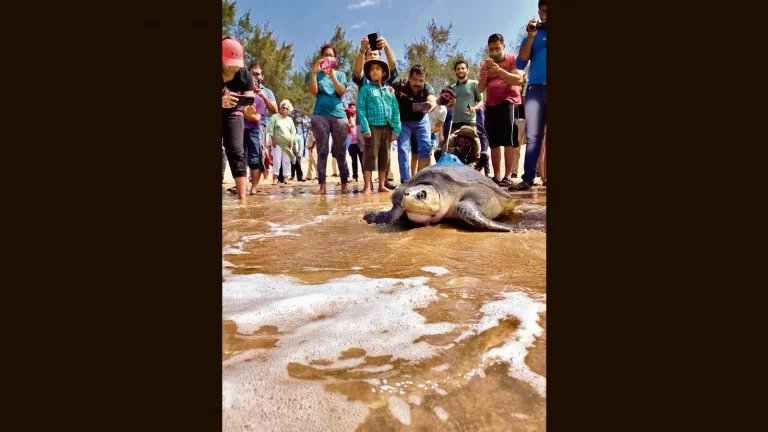
The olive ridley turtles that nest in Odisha forage for meals within the Bay of Bengal, migrate so far as the jap coast of Sri Lanka, and return to the identical Indian seashores, 12 months after 12 months, within the tens of 1000’s. Information on their actions has helped the Odisha authorities implement protecting measures and fishing bans in the course of the mating and nesting season.
There’s one other factor scientists have learnt about these turtles: They by no means swim round to the opposite coast, and by no means enterprise into the Arabian Sea. “Meaning the olive ridleys that go to the west coast of India may very well be a separate and distinct inhabitants,” says Harshal Karve, a marine biologist with the Mumbai-based Mangrove Basis, an autonomous unit working below the Maharashtra forest division.
{{^userSubscribed}}
{{/userSubscribed}}
{{^userSubscribed}}
{{/userSubscribed}}
Turtle nesting on the western coast of India doesn’t happen on something like the identical scale because it does in Odisha, however the numbers are nonetheless vital. About 690 olive ridley turtle nests had been recorded in Maharashtra within the 2021-22 season. The place had been they coming from? The place did they go? Did they too return to the identical Indian seashores every year?
To try to reply a few of these questions, a first-of-its-kind initiative was undertaken on the western coast. The Maharashtra forest division’s Mangrove Cell, the Mangrove Basis, and the Wildlife Institute of India joined arms to tag 5 feminine olive ridleys with satellite tv for pc trackers, in January and February 2022, earlier than they returned to the ocean.
Two of those turtles, named Prathma and Saavani, had been tagged on the Velas and Anjarle seashores; Vanashree, Lakshmi and Rewa had been tagged in Guhagar close to Ratnagiri.
{{^userSubscribed}}
{{/userSubscribed}}
{{^userSubscribed}}
{{/userSubscribed}}
Tagging a turtle isn’t as simple as tagging a hen or a mammal. Flippers can’t be fitted with a collar or anklet; these would fall proper off. So a transmitter is mounted to the highest of the turtle’s shell with industrial-strength glue, and the entire cap is then coated with anti-fouling paint (additionally used on the outsides of ships), to maintain barnacles and different marine creatures at bay.
{{^userSubscribed}}
{{/userSubscribed}}
{{^userSubscribed}}
{{/userSubscribed}}
Transmitters should have the ability to hyperlink up with a satellite tv for pc to ensure that information to be recorded. That hyperlink isn’t doable underwater. “However since turtles are reptiles, they should hold surfacing for air, and that’s after we get a success on their motion,” Karve says.
Within the weeks simply after the turtles returned to the ocean, an important discovering emerged. “Saavani visited a seashore simply 8 or 9 km from her earlier nesting website and nested once more there. Olive ridleys are identified to return to the identical nesting grounds, so this was very fascinating,” says Karve. Researchers had been additionally to seek out that the tagged females moved in numerous instructions, and a few didn’t enterprise removed from the coast of Maharashtra in any respect.
{{^userSubscribed}}
{{/userSubscribed}}
{{^userSubscribed}}
{{/userSubscribed}}
Sadly, the researchers misplaced contact with the turtles earlier than they’d anticipated. In March, Lakshmi’s sign went silent, close to Ganapatipule in Maharashtra. In June, they misplaced contact with Prathma, Saavani and Rewa, within the waters off Maharashtra and Karnataka. In August, Vanashree’s sign went chilly off the coast of Gujarat.
Manas Manjrekar, a deputy director for analysis and capacity-building programmes with the Mangrove Basis, says they’re wanting into why the transmitters didn’t last more. However already, with their findings, “we’re laying the bottom for conservation measures which may be wanted say 10 years down the road”.
The turtle-watchers are additionally hoping that when the turtles return subsequent 12 months, some may be tagged anew, and tracked additional and longer this time.
{{^userSubscribed}}
{{/userSubscribed}}
{{^userSubscribed}}
{{/userSubscribed}}